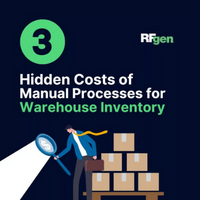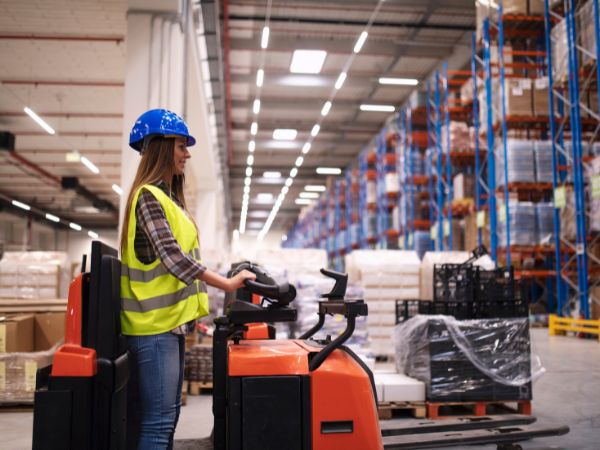9 Ways Mobile Data Collection Improves Safety for Workers in Your Warehouse
- Compliance
- Sustainability
- Workforce

It’s no secret that the warehouse setting can be dangerous. In fact, worker safety should be at the top of every warehouse manager’s priority list. If not operated thoughtfully, multiple workers are liable to be injured each year—or worse.
Vehicle accidents are the most common cause of unintentional deaths in warehouses, followed by injuries from slips, trips, and falls. If employers make their warehouses safer places to work, they may be able to reduce incidents, eliminating unnecessary overhead costs and improving morale.
One proven way to make your warehouse safer is to automate data collection. Mobile data collection not only streamlines operations but can significantly enhance worker safety. Here’s how—
1. Increase Data Collection Automation and Accuracy
The most important thing to do is to pinpoint potential hazards. Collecting data on hazardous substances, protective equipment malfunctions, sanitation procedures, mechanical repair reports, types of injuries, and where they occurred is essential to gain invaluable insights. With all this data, the right tools must be in place to manage it.
Mobile data collection serves as a crucial tool in this area, enabling management to better handle the influx of data. For instance, RFgen enables instant, flawless data collection for material handling. Collected data can then be visualized on live dashboards. From this, managers can leverage data-driven decision-making to proactively address safety concerns, ultimately fostering a safer workplace.
Mobile solutions also prevent repetitive movements and unnecessary reaches, twists, and walking, reducing incidents associated with the most common injury types.

Why People Are the Best Investment You Can Make
READ NOW »2. Fix Warehouse Layout
The layout of a warehouse floor is a critical factor in worker safety. Today’s customers are more demanding when it comes to delivery times and order quality. To meet that demand, many warehouse teams rush their work and get careless.
If the floor plan isn’t laid out with safety in mind, injuries are more likely to occur. Some improvements may include:
- Increasing the size of the receiving area to accommodate higher demand can prevent accidents by giving heavy machinery more room to operate.
- Widening aisles also gives large equipment more space to rapidly twist and turn. This prevents forklifts from knocking shelves onto employees working nearby.
- Reconfiguring storage so that higher-demand items are stored closer to picking and shipping areas to reduce the likelihood of unwanted collisions.
Mobile data collection solutions enable a strategic redesign of warehouse spaces to accommodate the increasing pace of operations while prioritizing safety. Advanced routing capabilities like those included in RFgen advanced warehousing also enable the intelligent direction of activities to optimize warehouse traffic flows.
By leveraging data collected on workflow and spatial usage, managers can make informed decisions to modify the warehouse structure. This not only aligns with the rising consumer expectations for quick deliveries but also establishes a foundation for a safer and more efficient work environment.

4 Steps to Redesign Your Warehouse Space
LEARN MORE »3. Improve Communication
Effective communication is vital in maintaining safety in a fast-paced warehouse. Not only about safety awareness, possible hazards, and best practices, but also in terms of data collection.
Workers who are constantly looking down at clipboards or paper printouts may not be paying attention to their surroundings. Trips and collisions are likely to occur. Instead of relying on these older, inefficient manual processes, mobile data collection can automate many of these tasks entirely.
Digital transformation of inventory processes improves efficiency and worker productivity by 30-42%. Since tasks take so much less time, workers aren’t as distracted. Meanwhile, automation ensures a seamless flow of accurate information, especially in high-risk areas.

Uncover the 3 Hidden Costs of Manual Processes in the Warehouse
DOWNLOAD NOW »4. Stay in Compliance with Government Regulations
Warehouses must follow a number of regulations set forth by the Occupational Safety and Health Administration, or OSHA. Failing to uphold these regulations can result in very hefty fines. They can also lead to accidents, dismemberment, and even death.
OSHA’s regulations for the warehouse include self-inspection safety checklists. Checklist items include asking whether open or exposed loading dock doors are chained off, roped off, or otherwise blocked.
Another item asks whether aisles are clear of debris and whether the allotted time given to employees to complete their jobs includes time to make sure they’re practicing safe work procedures.
Here, mobile automation can simplify compliance. Attestation steps in a mobile app may be used to ask these questions before and after operating machinery, elevating awareness for employees. Mobile data collection also ensures that every action and step taken by employees is automatically documented.
5. Real-Time Hazard Reporting
Introducing mobile data collection in the warehouse can significantly enhance real-time hazard reporting. Mobile devices provide on-demand access to alerts for workers.
This immediacy allows workers to quickly identify and report potential dangers, such as spills, equipment malfunctions, or unsafe conditions. Thanks to technology, the time between identifying a hazard and initiating a response is dramatically reduced, effectively mitigating risks and preventing accidents.
Collected data about hazard reporting can then be leveraged to inform decisions that further improve safety and efficiency.

4 Strategies for Maximizing Warehouse Safety
READ MORE »6. Enhanced Training and Onboarding
Incorporating mobile data collection in the warehouse has a large impact on training on onboarding. Mobile inventory solutions like RFgen drastically reduce training requirements for new and seasonal staff—up to 80%.
This allows more time for safety training. In addition, up-to-date training materials and safety protocols can be made accessible directly on mobile devices, or built into mobile apps for everyday tasks.
These steps ensure consistent and comprehensive training, reducing the likelihood of accidents due to unfamiliarity or misinformation.
7. Automated Safety Checks
Automated safety checks via mobile data collection streamline the process of ensuring a safe working environment. Regular safety inspections, crucial for identifying potential hazards, can be conducted more efficiently and thoroughly. Checklists and reminders for procedures (ex. lock out/tag out) on mobile devices ensure that inspections are not overlooked and are conducted at regular intervals.
This not only enhances safety but also fosters a culture of regular maintenance and vigilance. Automated checks also provide valuable data for continuous improvement of safety measures and protocols within the warehouse.
8. Incident Tracking and Analysis
As mentioned above, part of the beauty of automated data collection is the reliable decision-making that comes out of it.
Mobile data collection facilitates detailed incident tracking and analysis, crucial for understanding and preventing workplace accidents. Data from documented incidents enable the organization to analyze patterns and identify underlying causes.
Armed with data, targeted interventions and safety improvements are possible—and reduce the likelihood of similar incidents in the future.
In addition, this data can then inform training programs, highlighting areas that require more attention, and ensuring that safety measures are continuously updated in response to observed trends.
9. Emergency Response Coordination
Mobile devices play a pivotal role in emergency response coordination inside the warehouse. In critical situations, having immediate access to emergency protocols, contacts, and guidance on mobile devices can be lifesaving.
These tools enable swift communication among employees, ensuring everyone is informed and can respond effectively during emergencies, such as evacuations or medical crises.
Additionally, collected data can help in post-emergency analysis, allowing for the refinement of emergency response plans based on real-world scenarios, ultimately enhancing the preparedness and safety of the warehouse workforce.
Safety First with Mobile Data Collection
Integrating mobile data collection for your ERP represents a big stride toward enhancing operational efficiency and safety. From increasing data accuracy to simplifying compliance with government regulations, enterprise mobility software fosters greater responsiveness and agility.
Worker safety isn’t just a matter of well-being, but a financial solvency decision that impacts the bottom line. Mobile data collection solutions can be instrumental in reducing undesirable costs and waste, including when it comes to safety.
As mobile inventory software continues to evolve, it will become more essential to mitigating challenges in warehouse safety management, ensuring a secure and productive future for your business.




